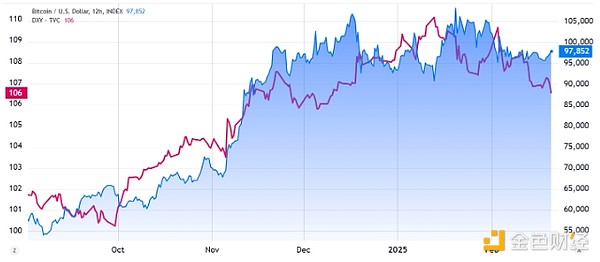Long-term low U.S. Treasury demand has sparked vigilance - Is BTC at risk?

Reprinted from jinse
02/21/2025·3MAuthor: Marcel Pechman, CoinTelegraph; Compilation: Baishui, Golden Finance
On February 20, the S &P 500 fell 1%, and the dollar weakened against a basket of foreign currencies, falling to its lowest level in 70 days. Bitcoin has shown a positive correlation with the USD Index (DXY) over the past six months, which has led traders to doubt whether a correction is about to occur.

DXY index (left) vs. Bitcoin/USD (right). Source: TradingView / Cointelegraph
While it is difficult to directly link the causal relationship between the U.S. dollar index and Bitcoin price, both rose between September 2024 and January 2025 and then faced the challenge of maintaining a bullish momentum.
Some analysts believe that the election of U.S. President Donald Trump has promoted fiscal policy, which could lead to a stronger country's currency. However, recent data (whether attributed to the previous administration or not) show that U.S. inflation continues and weak retail sales, indicating a possible "stagflation" in the future.
It is too early to assess the full impact of recent import tariffs and government budget cuts, but Raymond James Chief Investment Officer Larry Adam stressed in a Feb. 14 report that this could It will have a negative impact on U.S. GDP growth of 0.6%, and warns that inflation may rise by 0.5%. Although this situation itself is not good for Bitcoin, it may curb investors ' risk appetite.
DXY index puts pressure on Bitcoin price, but trends may weaken
On February 20, U.S. Treasury Secretary Scott Bescent said the government has not yet moved towards issuing more long-term bonds. “It’s still a long way to go,” Becente commented. Despite previous criticisms of Janet Yellen for favoring short-term debt, the previous administration's approach has not changed.
Any move toward long-term bonds will depend on market conditions and inflation trends and attribute the current situation to "Biden inflation." However, more worryingly, Becente noted that “when I don’t compete with the Fed, it’s easier for me to extend the period”, which has been a “big seller” of government bonds.
Positive correlation with the DXY index puts downward pressure on the price of Bitcoin. However, this trend may weaken as investors transform Bitcoin from risky assets to scarce hedge assets similar to “digital gold.” This shift is partly due to the fact that several U.S. states have introduced legislation that allows Bitcoin to become a reserve asset.
On February 19, the Montana Business and Labor Commission passed a bill to create a special income account that invests in precious metals and bitcoin. Other states, including Utah, Arizona, Oklahoma, Illinois, Kentucky, Maryland, New Hampshire, New Mexico, North Dakota, Ohio, Pennsylvania, South Dakota and Texas, The Bitcoin Reserve Act was also proposed.
On February 20, the price of Bitcoin exceeded $98,000, indicating that investors are increasingly aware of its tough monetary policy. This is especially important given the high risk of the U.S. government adopting an expansionary monetary policy (for example, if Elon Musk’s Department of Efficiency meets its spending cut goals).
Investor caution is also reflected in gold prices, as the precious metal hit an all-time high on February 19. Traders should not only focus on how the US dollar performs relative to other currencies, but on how nation-states evaluate Bitcoin. Aleš Michl, President of the Czech National Bank, stressed the importance of evaluating the potential of Bitcoin as a reserve asset.
Ultimately, Bitcoin’s path to an all-time high depends heavily on the inflow of spot Bitcoin exchange-traded funds (ETFs), the preferred tool for institutional investors – according to Farside Investors, the past two days has not been In this way, the cumulative net outflow was US$125 million.


 panewslab
panewslab